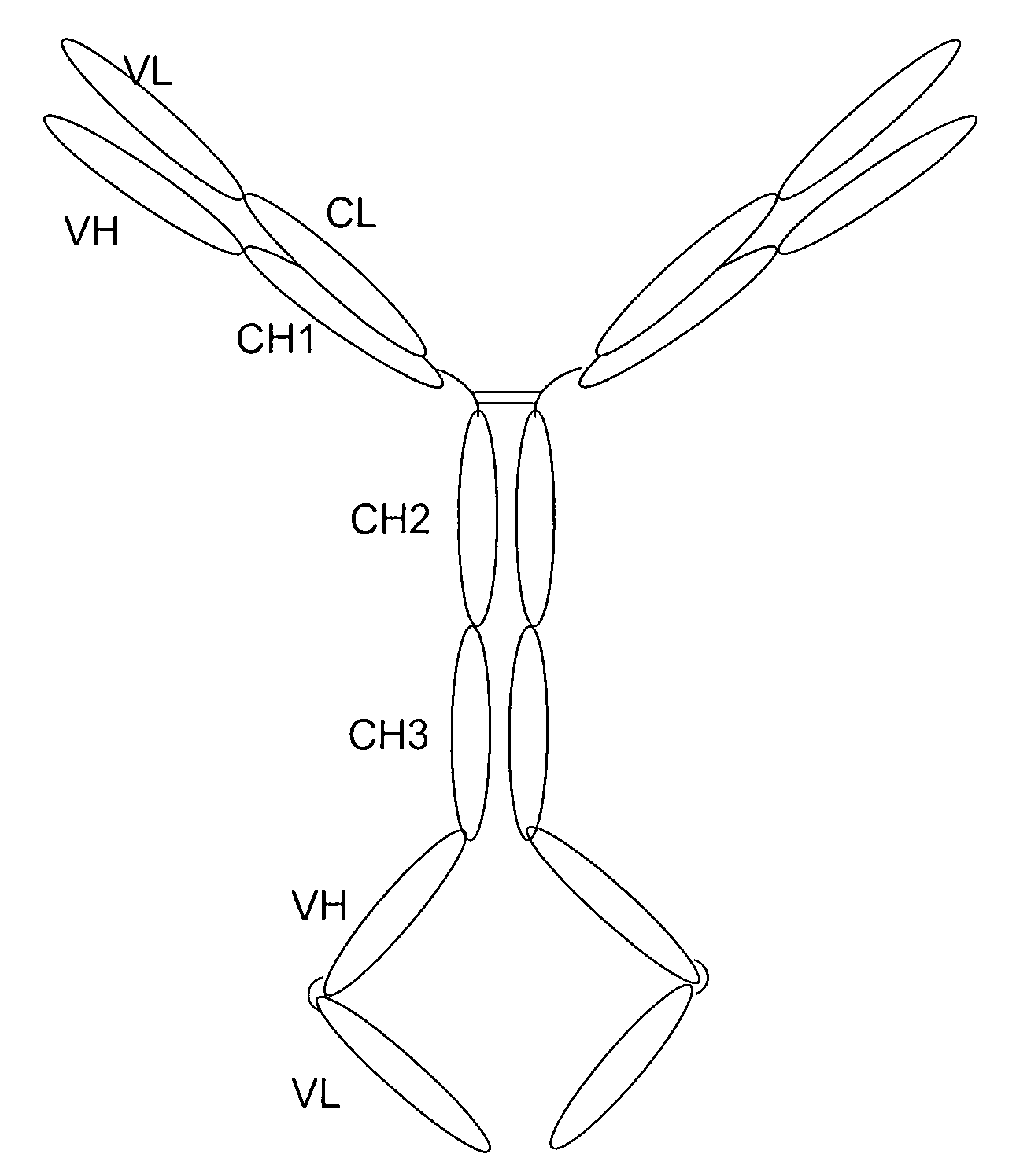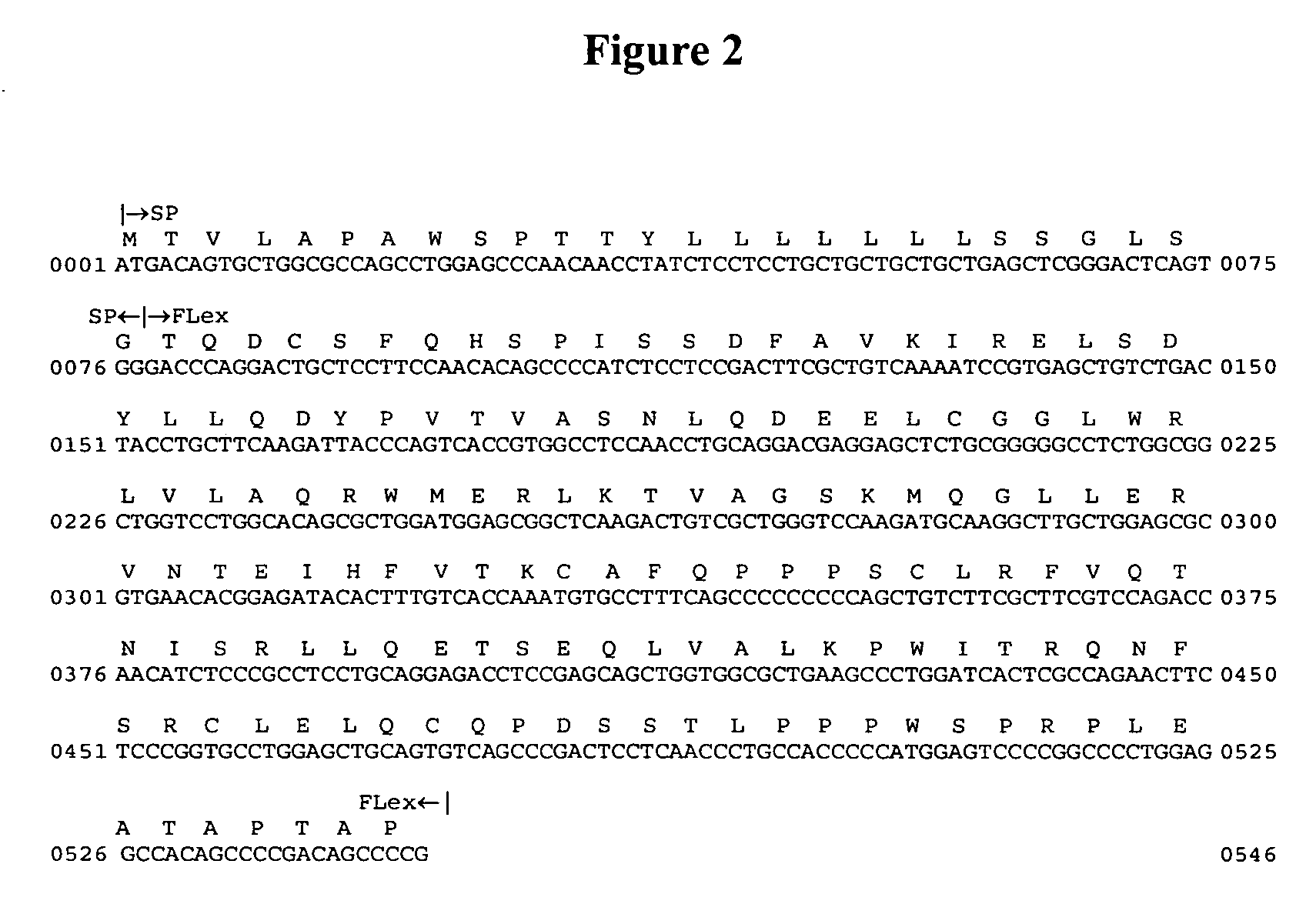Preparation and application of anti-tumor bifunctional fusion proteins
a technology of fusion proteins and tumors, applied in the field of tumor immunology, can solve the problems of inoperable tumor burden in patients with hepatoma, untreated micrometastases, and inability to detect micrometastases, and achieve the effects of preventing tumor growth recurrence, reducing tumor burden, and infiltrating tumor tissues
- Summary
- Abstract
- Description
- Claims
- Application Information
AI Technical Summary
Benefits of technology
Problems solved by technology
Method used
Image
Examples
example 1
Human Flt3 Ligand Extracellular Region (hFLex) cDNA Synthesis
[0164] Purpose: Because the Flt3 ligand is a type I transmembrane protein whose extracellular region is at the N terminus, modification of the N terminus of FL may adversely affect its biological activities. Therefore, we employed a methodology used to construct a tetravalent biospecific antibody (see FIG. 1A). See Column et al., Nat Biotech 15:159-163 (1997). Typically, the tetravalent bispecific antibodies were constructed by fusing the DNA encoding a single chain antibody at the C terminus of an antibody with a different specificity. In order to obtain bifunctional fusion protein with high biological activities, we constructed a fusion protein with FLex at N the terminus and the antibody molecule at the C terminus (see FIG. 1B). First, the FLex gene was fused to the 5′end of a human IgG1 cDNA (hinge plus CH2 plus CH3) to generate the Flex-Ig fusion gene. Then the hFLex-Ig fusion gene was fused to the 5′ end of a single...
example 2
Cloning and Identification of the Constant Region of Human IgG1
[0169] The native human IgG1 cDNA of 1416 bp encodes 471 amino acids and a translation termination codon. The constant region of IgG1 was cloned by RT-PCR using the following protocol: Human peripheral blood mononuclear cells (PBMCs) were isolated from heparinized blood of healthy volunteers by Ficoll-Hypaque density gradient centrifugation. RNA was isolated from PBMCs with TRIzol Reagent (Gibco BRL). The cDNA of IgG1 Fc fragment was obtained by Onestep RT-PCR (Qiagen). The primers for RT-PCR were as follows: Fc sense, 5′-gca ctc gag ttt tac ccg gag aca ggg aga g-3′; Fc antisense, 5′-gag ccc aaa tct tgt gac aaa ac-3′. The RT-PCR products were separated on agarose gel. The correct DNA fragment was gel-purified and cloned into pGEM-T vector (Promega), and its sequence was verified. The clone was denoted pGEM-T / IgFc.
example 3
Construction of SM5-1 Chimeric Antibody and Humanized Antibody
[0170] 1. Cloning of mouse SM5-1 heavy and light chain variable region genes. RNA was isolated from SM5-1 (IgG1, κ) hybridoma cells (deposited at ATCC having ATCC Designation No. HB-12588) with TRIzol Reagent (Gibco BRL, Grand Island, N.Y.). The heavy and light variable region cDNAs of SM5-1 were cloned from hybridoma cells using 5′RACE system (Gibco BRL, Gaithersburg, Md.) according to the manufacture's instructions. The nested PCR products were analyzed by agarose gel electrophoresis (FIG. 5). The specific heavy chain PCR fragments of about 590 bp and light chain fragment of about 530 bp were gel-purified and cloned into pGEM-T vector (Promega, Madison, Wis.) for sequence determination, respectively. The DNA sequences of heavy (SM VH) and light (SM, VL) variable region are SEQ ID NO:7 (FIG. 6) and SEQ ID NO:9 (FIG. 7), respectively.
[0171] 2. Construction of expression vectors for chimeric antibodies. The two vectors p...
PUM
| Property | Measurement | Unit |
|---|---|---|
| soluble | aaaaa | aaaaa |
| nucleic acid | aaaaa | aaaaa |
| β-lactamase | aaaaa | aaaaa |
Abstract
Description
Claims
Application Information
 Login to View More
Login to View More - R&D
- Intellectual Property
- Life Sciences
- Materials
- Tech Scout
- Unparalleled Data Quality
- Higher Quality Content
- 60% Fewer Hallucinations
Browse by: Latest US Patents, China's latest patents, Technical Efficacy Thesaurus, Application Domain, Technology Topic, Popular Technical Reports.
© 2025 PatSnap. All rights reserved.Legal|Privacy policy|Modern Slavery Act Transparency Statement|Sitemap|About US| Contact US: help@patsnap.com



